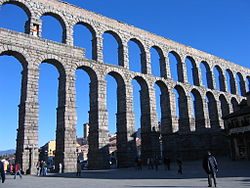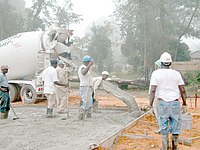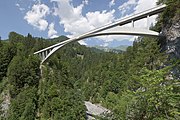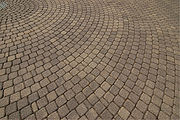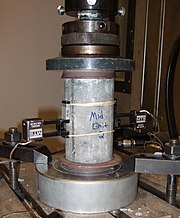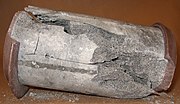Concrete
From Wikipedia, the free encyclopedia
Concrete is a construction material composed of cement (commonly Portland cement) as well as other cementitious materials such as fly ash and slag cement, aggregate (generally a coarse aggregate such as gravel, limestone, or granite, plus a fine aggregate such as sand), water, and chemical admixtures. The word concrete comes from the Latin word "concretus", which means "hardened" or "hard".
Concrete solidifies and hardens after mixing with water and placement due to a chemical process known as hydration. The water reacts with the cement, which bonds the other components together, eventually creating a stone-like material. Concrete is used to make pavements, architectural structures, foundations, motorways/roads, bridges/overpasses, parking structures, brick/block walls and footings for gates, fences and poles.
Concrete is used more than any other man-made material in the world.[1] As of 2006, about 7.5 cubic kilometres of concrete are made each year—more than one cubic metre for every person on Earth.[2] Concrete powers a US $35-billion industry which employs more than two million workers in the United States alone.[citation needed] More than 55,000 miles (89,000 km) of highways in America are paved with this material. The People's Republic of China currently consumes 40% of the world's cement/concrete production.[citation needed]
Reinforced concrete and Prestressed concrete are the most widely used modern kinds of concrete functional extensions.
[edit] History
Many ancient civilizations used forms of concrete using dried mud, straw, and other materials.
During the Roman Empire, Roman concrete was made from quicklime, pozzolanic ash/pozzolana, and an aggregate of pumice; it was very similar to modern Portland cement concrete. The widespread use of concrete in many Roman structures has ensured that many survive almost intact to the present day. The Baths of Caracalla in Rome are just one example of the longevity of concrete, which allowed the Romans to build this and similar structures across the Roman Empire. Many Roman aqueducts have masonry cladding to a concrete core, a technique they used in structures such as the Pantheon, Rome, the dome of which is concrete.
The secret of concrete was lost for 13 centuries until 1756, when the British engineer John Smeaton pioneered the use of hydraulic lime in concrete, using pebbles and powdered brick as aggregate. Portland cement was first used in concrete in the early 1840s. This version of history has been challenged however, as the Canal du Midi was constructed using concrete in 1670.[3]
Recently, the use of recycled materials as concrete ingredients is gaining popularity because of increasingly stringent environmental legislation. The most conspicuous of these is fly ash, a by-product of coal-fired power plants. This has a significant impact by reducing the amount of quarrying and landfill space required, and, as it acts as a cement replacement, reduces the amount of cement required to produce a solid concrete. As cement production creates massive quantities of carbon dioxide, cement-replacement technology such as this will play an important role in future attempts to cut carbon dioxide emissions.
Concrete additives have been used since Roman and Egyptian times, when it was discovered that adding volcanic ash to the mix allowed it to set under water. Similarly, the Romans knew that adding horse hair made concrete less liable to crack while it hardened, and adding blood made it more frost-resistant[4].
In modern times, researchers have experimented with the addition of other materials to create concrete with improved properties, such as higher strength or electrical conductivity.
[edit] Composition
There are many types of concrete available, created by varying the proportions of the main ingredients below.
The mix design depends on the type of structure being built, how the concrete will be mixed and delivered, and how it will be placed to form this structure.
[edit] Cement
Portland cement is the most common type of cement in general usage. It is a basic ingredient of concrete, mortar, and plaster. English engineer Joseph Aspdin patented Portland cement in 1824; it was named because of its similarity in colour to Portland limestone, quarried from the English Isle of Portland and used extensively in London architecture. It consists of a mixture of oxides of calcium, silicon and aluminium. Portland cement and similar materials are made by heating limestone (a source of calcium) with clay, and grinding this product (called clinker) with a source of sulfate (most commonly gypsum). The manufacturing of Portland cement creates about 5 percent of human CO2 emissions.[5]
[edit] Water
Combining water with a cementitious material forms a cement paste by the process of hydration. The cement paste glues the aggregate together, fills voids within it, and allows it to flow more easily.
Less water in the cement paste will yield a stronger, more durable concrete; more water will give an easier-flowing concrete with a higher slump.[6]
Impure water used to make concrete can cause problems, when setting, or in causing premature failure of the structure.
Hydration involves many different reactions, often occurring at the same time. As the reactions proceed, the products of the cement hydration process gradually bond together the individual sand and gravel particles, and other components of the concrete, to form a solid mass.
Reaction:
- Cement chemist notation: C3S + H2O → CSH(gel) + CaOH
- Standard notation: Ca3SiO5 + H2O → (CaO)•(SiO2)•(H2O)(gel) + Ca(OH)2
- Balanced: 2Ca3SiO5 + 7H2O → 3(CaO)•2(SiO2)•4(H2O)(gel) + 3Ca(OH)2
[edit] Aggregates
Fine and coarse aggregates make up the bulk of a concrete mixture. Sand, natural gravel and crushed stone are mainly used for this purpose. Recycled aggregates (from construction, demolition and excavation waste) are increasingly used as partial replacements of natural aggregates, while a number of manufactured aggregates, including air-cooled blast furnace slag and bottom ash are also permitted.
Decorative stones such as quartzite, small river stones or crushed glass are sometimes added to the surface of concrete for a decorative "exposed aggregate" finish, popular among landscape designers.
[edit] Reinforcement
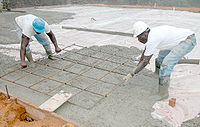
Concrete is strong in compression, as the aggregate efficiently carries the compression load. However, it is weak in tension as the cement holding the aggregate in place can crack, allowing the structure to fail. Reinforced concrete solves these problems by adding either metal reinforcing bars, glass fiber, or plastic fiber to carry tensile loads.
[edit] Chemical admixtures
Chemical admixtures are materials in the form of powder or fluids that are added to the concrete to give it certain characteristics not obtainable with plain concrete mixes. In normal use, admixture dosages are less than 5% by mass of cement, and are added to the concrete at the time of batching/mixing.[7] The most common types of admixtures [8] are:
- Accelerators speed up the hydration (hardening) of the concrete. Typical materials used are CaCl2 and NaCl.
- Retarders slow the hydration of concrete, and are used in large or difficult pours where partial setting before the pour is complete is undesirable. A typical retarder is sugar (C6H12O6).
- Air entrainments add and distribute tiny air bubbles in the concrete, which will reduce damage during freeze-thaw cycles thereby increasing the concrete's durability. However, entrained air is a trade-off with strength, as each 1% of air may result in 5% decrease in compressive strength.
- Plasticizers (water-reducing admixtures) increase the workability of plastic or "fresh" concrete, allowing it be placed more easily, with less consolidating effort. Superplasticizers (high-range water-reducing admixtures) are a class of plasticizers which have fewer deleterious effects when used to significantly increase workability. Alternatively, plasticizers can be used to reduce the water content of a concrete (and have been called water reducers due to this application) while maintaining workability. This improves its strength and durability characteristics.
- Pigments can be used to change the color of concrete, for aesthetics.
- Corrosion inhibitors are used to minimize the corrosion of steel and steel bars in concrete.
- Bonding agents are used to create a bond between old and new concrete.
- Pumping aids improve pumpability, thicken the paste, and reduce dewatering – the tendency for the water to separate out of the paste.
[edit] Mineral admixtures and blended cements

There are inorganic materials that also have pozzolanic or latent hydraulic properties. These very fine-grained materials are added to the concrete mix to improve the properties of concrete (mineral admixtures),[7] or as a replacement for Portland cement (blended cements).[9]
- Fly ash: A by product of coal fired electric generating plants, it is used to partially replace Portland cement (by up to 60% by mass). The properties of fly ash depend on the type of coal burnt. In general, silicious fly ash is pozzolanic, while calcareous fly ash has latent hydraulic properties.[10]
- Ground granulated blast furnace slag (GGBFS or GGBS): A by product of steel production, is used to partially replace Portland cement (by up to 80% by mass). It has latent hydraulic properties.[11]
- Silica fume: A by-product of the production of silicon and ferrosilicon alloys. Silica fume is similar to fly ash, but has a particle size 100 times smaller. This results in a higher surface to volume ratio and a much faster pozzolanic reaction. Silica fume is used to increase strength and durability of concrete, but generally requires the use of superplasticizers for workability.[12]
- High Reactivity Metakaolin (HRM): Metakaolin produces concrete with strength and durability similar to concrete made with silica fume. While silica fume is usually dark gray or black in color, high reactivity metakaolin is usually bright white in color, making it the preferred choice for architectural concrete where appearance is important.
[edit] Concrete production
The processes used vary dramatically, from hand tools to heavy industry, but result in the concrete being placed where it cures into a final form.
When initially mixed together, Portland cement and water rapidly form a gel, formed of tangled chains of interlocking crystals. These continue to react over time, with the initially fluid gel often aiding in placement by improving workability. As the concrete sets, the chains of crystals join up, and form a rigid structure, gluing the aggregate particles in place. During curing, more of the cement reacts with the residual water (Hydration).
This curing process develops physical and chemical properties. Among other qualities, mechanical strength, low moisture permeability, and chemical and volumetric stability.
[edit] Mixing concrete
Thorough mixing is essential for the production of uniform, high quality concrete. Therefore, equipment and methods should be capable of effectively mixing concrete materials containing the largest specified aggregate to produce uniform mixtures of the lowest slump practical for the work. Separate paste mixing has shown that the mixing of cement and water into a paste before combining these materials with aggregates can increase the compressive strength of the resulting concrete.[13] The paste is generally mixed in a high-speed, shear-type mixer at a w/cm (water to cement ratio) of 0.30 to 0.45 by mass. The cement paste premix may include admixtures, e.g. accelerators or retarders, plasticizers, pigments, or fumed silica. The latter is added to fill the gaps between the cement particles. This reduces the particle distance and leads to a higher final compressive strength and a higher water impermeability.[14] The premixed paste is then blended with aggregates and any remaining batch water, and final mixing is completed in conventional concrete mixing equipment.[15]
High-Energy Mixed Concrete (HEM concrete) is produced by means of high-speed mixing of cement, water and sand with net specific energy consumption at least 5 kilojoules per kilogram of the mix. It is then added to a plasticizer admixture and mixed after that with aggregates in conventional concrete mixer. This paste can be used itself or foamed (expanded) for lightweight concrete.[16] Sand effectively dissipates energy in this mixing process. HEM concrete fast hardens in ordinary and low temperature conditions, and possesses increased volume of gel, drastically reducing capillarity in solid and porous materials. It is recommended for precast concrete in order to reduce quantity of cement, as well as concrete roof and siding tiles, paving stones and lightweight concrete block production.
[edit] Workability
Workability is the ability of a fresh (plastic) concrete mix to fill the form/mold properly with the desired work (vibration) and without reducing the concrete's quality. Workability depends on water content, aggregate (shape and size distribution), cementitious content and age (level of hydration), and can be modified by adding chemical admixtures. Raising the water content or adding chemical admixtures will increase concrete workability. Excessive water will lead to increased bleeding (surface water) and/or segregation of aggregates (when the cement and aggregates start to separate), with the resulting concrete having reduced quality. The use of an aggregate with an undesirable gradation can result in a very harsh mix design with a very low slump, which cannot be readily made more workable by addition of reasonable amounts of water.
Workability can be measured by the Concrete Slump Test, a simplistic measure of the plasticity of a fresh batch of concrete following the ASTM C 143 or EN 12350-2 test standards. Slump is normally measured by filling an "Abrams cone" with a sample from a fresh batch of concrete. The cone is placed with the wide end down onto a level, non-absorptive surface. It is then filled in three layers of equal volume, with each layer being tamped with a steel rod in order to consolidate the layer. When the cone is carefully lifted off, the enclosed material will slump a certain amount due to gravity. A relatively dry sample will slump very little, having a slump value of one or two inches (25 or 50 mm). A relatively wet concrete sample may slump as much as six or seven inches (150 to 175 mm).
Slump can be increased by adding chemical admixtures such as mid-range or high-range water reducing agents (super-plasticizers) without changing the water/cement ratio. It is bad practice to add excessive water upon delivery to the jobsite, however in a properly designed mixture it is important to reasonably achieve the specified slump prior to placement as design factors such as air content, internal water for hydration/strength gain, etc. are dependent on placement at design slump values.
High-flow concrete, like self-consolidating concrete, is tested by other flow-measuring methods. One of these methods includes placing the cone on the narrow end and observing how the mix flows through the cone while it is gradually lifted.
[edit] Curing
In all but the least critical applications, care needs to be taken to properly cure concrete, and achieve best strength and hardness. This happens after the concrete has been placed. Cement requires a moist, controlled environment to gain strength and harden fully. The cement paste hardens over time, initially setting and becoming rigid though very weak, and gaining in strength in the days and weeks following. In around 3 weeks, over 90% of the final strength is typically reached though it may continue to strengthen for decades.[17]
Hydration and hardening of concrete during the first three days is critical. Abnormally fast drying and shrinkage due to factors such as evaporation from wind during placement may lead to increased tensile stresses at a time when it has not yet gained significant strength, resulting in greater shrinkage cracking. The early strength of the concrete can be increased by keeping it damp for a longer period during the curing process. Minimizing stress prior to curing minimizes cracking. High early-strength concrete is designed to hydrate faster, often by increased use of cement which increases shrinkage and cracking.
During this period concrete needs to be in conditions with a controlled temperature and humid atmosphere. In practice, this is achieved by spraying or ponding the concrete surface with water, thereby protecting concrete mass from ill effects of ambient conditions. The pictures to the right show two of many ways to achieve this, ponding – submerging setting concrete in water, and wrapping in plastic to contain the water in the mix.
Properly curing concrete leads to increased strength and lower permeability, and avoids cracking where the surface dries out prematurely. Care must also be taken to avoid freezing, or overheating due to the exothermic setting of cement (the Hoover Dam used pipes carrying coolant during setting to avoid damaging overheating). Improper curing can cause scaling, reduced strength, poor abrasion resistance and cracking.
[edit] Properties
[edit] Strength
Concrete has relatively high compressive strength, but significantly lower tensile strength. It is fair to assume that a concrete sample's tensile strength is about 10%-15% of its compressive strength.[18] As a result, without compensating, concrete would almost always fail from tensile stresses – even when loaded in compression. The practical implication of this is that concrete elements subjected to tensile stresses must be reinforced with materials that are strong in tension.
Reinforced concrete is the most common form of concrete. The reinforcement is often steel, rebar (mesh, spiral, bars and other forms). Structural fibers of various materials are available.
Concrete can also be prestressed (reducing tensile stress) using internal steel cables (tendons), allowing for beams or slabs with a longer span than is practical with reinforced concrete alone. Inspection of concrete structures can be non-destructive if carried out with equipment such as a Schmidt hammer, which is used to estimate concrete strength.
The ultimate strength of concrete is influenced by the water-cementitious ratio (w/cm), the design constituents, and the mixing, placement and curing methods employed. All things being equal, concrete with a lower water-cement (cementitious) ratio makes a stronger concrete than that with a higher ratio. The total quantity of cementitious materials (Portland cement, slag cement, pozzolans) can affect strength, water demand, shrinkage, abrasion resistance and density. All concrete will crack independent of whether or not it has sufficient compressive strength. In fact, high Portland cement content mixtures can actually crack more readily due to increased hydration rate. As concrete transforms from its plastic state, hydrating to a solid, the material undergoes shrinkage. Plastic shrinkage cracks can occur soon after placement but if the evaporation rate is high they often can actually occur during finishing operations, for example in hot weather or a breezy day. In very high strength concrete mixtures (greater than 10,000 psi) the crushing strength of the aggregate can be a limiting factor to the ultimate compressive strength. In lean concretes (with a high water-cement ratio) the crushing strength of the aggregates is not so significant.
The internal forces in common shapes of structure, such as arches, vaults, columns and walls are predominantly compressive forces, with floors and pavements subjected to tensile forces. Compressive strength is widely used for specification requirement and quality control of concrete. The engineer knows his target tensile (flexural) requirements and will express these in terms of compressive strength.
Wired.com reported on April 13, 2007 that a team from the University of Tehran, competing in a contest sponsored by the American Concrete Institute, demonstrated several blocks of concretes with abnormally high compressive strengths between 50,000 and 60,000 PSI at 28 days.[19] The blocks appeared to use an aggregate of steel fibres and quartz – a mineral with a compressive strength of 160,000 PSI, much higher than typical high-strength aggregates such as granite (15,000-20,000 PSI).
[edit] Elasticity
The modulus of elasticity of concrete is a function of the modulus of elasticity of the aggregates and the cement matrix and their relative proportions. The modulus of elasticity of concrete is relatively constant at low stress levels but starts decreasing at higher stress levels as matrix cracking develops. The elastic modulus of the hardened paste may be in the order of 10-30 GPa and aggregates about 45 to 85 GPa. The concrete composite is then in the range of 30 to 50 GPa.
The American Concrete Institute allows the modulus of elasticity to be calculated using the following equation:[18]
 (psi)
(psi)
where
- wc = weight of concrete (pounds per cubic foot) and where

- f'c = compressive strength of concrete at 28 days (psi)
This equation is completely empirical and is not based on theory. Note that the value of Ec found is in units of psi. For normalweight concrete (defined as concrete with a wc of 150 pcf) Ec is permitted to be taken as  .
.
[edit] Expansion and shrinkage
Concrete has a very low coefficient of thermal expansion. However, if no provision is made for expansion, very large forces can be created, causing cracks in parts of the structure not capable of withstanding the force or the repeated cycles of expansion and contraction.
As concrete matures it continues to shrink, due to the ongoing reaction taking place in the material, although the rate of shrinkage falls relatively quickly and keeps reducing over time (for all practical purposes concrete is usually considered to not shrink due to hydration any further after 30 years). The relative shrinkage and expansion of concrete and brickwork require careful accommodation when the two forms of construction interface.
Because concrete is continuously shrinking for years after it is initially placed, it is generally accepted that under thermal loading it will never expand to its originally placed volume.
[edit] Cracking
All concrete structures will crack to some extent. One of the early designers of reinforced concrete, Robert Maillart, employed reinforced concrete in a number of arched bridges. His first bridge was simple, using a large volume of concrete. He then realized that much of the concrete was very cracked, and could not be a part of the structure under compressive loads, yet the structure clearly worked. His later designs simply removed the cracked areas, leaving slender, beautiful concrete arches. The Salginatobel Bridge is an example of this.
Concrete cracks due to tensile stress induced by shrinkage or stresses occurring during setting or use. Various means are used to overcome this. Fiber reinforced concrete uses fine fibers distributed throughout the mix or larger metal or other reinforcement elements to limit the size and extent of cracks. In many large structures joints or concealed saw-cuts are placed in the concrete as it sets to make the inevitable cracks occur where they can be managed and out of sight. Water tanks and highways are examples of structures requiring crack control.
[edit] Shrinkage cracking
Shrinkage cracks occur when concrete members undergo restrained volumetric changes (shrinkage) as a result of either drying, autogenous shrinkage or thermal effects. Restraint is provided either externally (i.e. supports, walls, and other boundary conditions) or internally (differential drying shrinkage, reinforcement). Once the tensile strength of the concrete is exceeded, a crack will develop. The number and width of shrinkage cracks that develop are influenced by the amount of shrinkage that occurs, the amount of restraint present and the amount and spacing of reinforcement provided.
Plastic-shrinkage cracks are immediately apparent, visible within 0 to 2 days of placement, while drying-shrinkage cracks develop over time. Autogenous shrinkage also occurs when the concrete is quite young and results from the volume reduction resulting from the chemical reaction of the portland cement.
[edit] Tension cracking
Concrete members may be put into tension by applied loads. This is most common in concrete beams where a transversely applied load will put one surface into compression and the opposite surface into tension due to induced bending. The portion of the beam that is in tension may crack. The size and length of cracks is dependent on the magnitude of the bending moment and the design of the reinforcing in the beam at the point under consideration. Reinforced concrete beams are designed to crack in tension rather than in compression. This is achieved by providing reinforcing steel which yields before failure of the concrete in compression occurs and allowing remediation, repair, or if necessary, evacuation of an unsafe area.
[edit] Creep
Creep is the term used to describe the permanent movement or deformation of a material in order to relieve stresses within the material. Concrete which is subjected to long-duration forces is prone to creep. Short-duration forces (such as wind or earthquakes) do not cause creep. Creep can sometimes reduce the amount of cracking that occurs in a concrete structure or element, but it also must be controlled. The amount of primary and secondary reinforcing in concrete structures contributes to a reduction in the amount of shrinkage, creep and cracking.
[edit] Physical properties
The coefficient of thermal expansion of Portland cement concrete is 0.000008 to 0.000012 (per degree Celsius) (8-12 1/MK).[20] The density varies, but is around 150 pounds per cubic foot (2400 kg/m³).[21]
[edit] Damage modes
[edit] Fire
Due to its low thermal conductivity, a layer of concrete is frequently used for fireproofing of steel structures. However, concrete itself may be damaged by fire.
Up to about 300 °C, the concrete undergoes normal thermal expansion. Above that temperature, shrinkage occurs due to water loss; however, the aggregate continues expanding, which causes internal stresses. Up to about 500 °C, the major structural changes are carbonation and coarsening of pores. At 573 °C, quartz undergoes rapid expansion due to Phase transition, and at 900 °C calcite starts shrinking due to decomposition. At 450-550 °C the cement hydrate decomposes, yielding calcium oxide. Calcium carbonate decomposes at about 600 °C. Rehydration of the calcium oxide on cooling of the structure causes expansion, which can cause damage to material which withstood fire without falling apart. Concrete in buildings that experienced a fire and were left standing for several years shows extensive degree of carbonation.
Concrete exposed to up to 100 °C is normally considered as healthy. The parts of a concrete structure that is exposed to temperatures above approximately 300 °C (dependent of water/cement ratio) will most likely get a pink color. Over approximately 600 °C the concrete will turn light grey, and over approximately 1000 °C it turns yellow-brown.[22] One rule of thumb is to consider all pink colored concrete as damaged that should be removed.
Fire will expose the concrete to gases and liquids that can be harmful to the concrete, among other salts and acids that occur when gasses produced by fire come into contact with water.
[edit] Aggregate expansion
Various types of aggregate undergo chemical reactions in concrete, leading to damaging expansive phenomena. The most common are those containing reactive silica, that can react (in the presence of water) with the alkalis in concrete (K2O and Na2O, coming principally from cement). Among the more reactive mineral components of some aggregates are opal, chalcedony, flint and strained quartz. Following the reaction (Alkali Silica Reaction or ASR), an expansive gel forms, that creates extensive cracks and damage on structural members. On the surface of concrete pavements the ASR can cause pop-outs, i.e. the expulsion of small cones (up to 3 cm about in diameter) in correspondence of aggregate particles. When some aggregates containing dolomite are used, a dedolomitization reaction occurs where the magnesium carbonate compound reacts with hydroxyl ions and yields magnesium hydroxide and a carbonate ion. The resulting expansion may cause destruction of the material. Far less common are pop-outs caused by the presence of pyrite, an iron sulfide that generates expansion by forming iron oxide and ettringite. Other reactions and recrystallizations, e.g. hydration of clay minerals in some aggregates, may lead to destructive expansion as well.
[edit] Sea water effects
Concrete exposed to sea water is susceptible to its corrosive effects. The effects are more pronounced above the tidal zone than where the concrete is permanently submerged. In the submerged zone, magnesium and hydrogen carbonate ions precipitate a layer of brucite, about 30 micrometers thick, on which a slower deposition of calcium carbonate as aragonite occurs. These layers somewhat protect the concrete from other processes, which include attack by magnesium, chloride and sulfate ions and carbonation. Above the water surface, mechanical damage may occur by erosion by waves themselves or sand and gravel they carry, and by crystallization of salts from water soaking into the concrete pores and then drying up. Pozzolanic cements and cements using more than 60% of slag as aggregate are more resistant to sea water than pure Portland cement.
[edit] Bacterial corrosion
Bacteria themselves do not have noticeable effect on concrete. However, anaerobic bacteria (Thiobacillus) in untreated sewage tend to produce hydrogen sulfide, which is then oxidized by aerobic bacteria present in biofilm on the concrete surface above the water level to sulfuric acid which dissolves the carbonates in the cured cement and causes strength loss. Concrete floors lying on ground that contains pyrite are also at risk. Using limestone as the aggregate makes the concrete more resistant to acids, and the sewage may be pretreated by ways increasing pH or oxidizing or precipitating the sulfides in order to inhibit the activity of sulfide utilizing bacteria.
[edit] Chemical damage
[edit] Carbonation
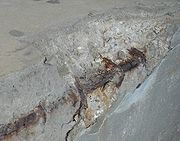
Carbon dioxide from air can react with the calcium hydroxide in concrete to form calcium carbonate. This process is called carbonation, which is essentially the reversal of the chemical process of calcination of lime taking place in a cement kiln. Carbonation of concrete is a slow and continuous process progressing from the outer surface inward, but slows down with increasing diffusion depth. Carbonation has two effects: it increases mechanical strength of concrete, but it also decreases alkalinity, which is essential for corrosion prevention of the reinforcement steel. Below a pH of 10, the steel's thin layer of surface passivation dissolves and corrosion is promoted. For the latter reason, carbonation is an unwanted process in concrete chemistry. Carbonation can be tested by applying Phenolphthalein solution, a pH indicator, over a fresh fracture surface, which indicates non-carbonated and thus alkaline areas with a violet color.
[edit] Chlorides
Chlorides, particularly calcium chloride, have been used to shorten the setting time of concrete.[23] However, calcium chloride and (to a lesser extent) sodium chloride have been shown to leach calcium hydroxide and cause chemical changes in Portland cement, leading to loss of strength,[24] as well as attacking the steel reinforcement present in most concrete.
[edit] Sulphates
Sulphates in solution in contact with concrete can cause chemical changes to the cement, which can cause significant microstructural effects leading to the weakening of the cement binder.
[edit] Distillate Water
Distillate water can wash out calcium content in concrete, leaving the concrete in brittle condition. Source of distillate water such as steam or hot water.
[edit] Leaching
| This section requires expansion. |
Leaching is a self healing of cracks with chemical process in concrete.
[edit] Physical damage
Damage can occur during the casting and de-shuttering processes. For instance, the corners of beams can be damaged during the removal of shuttering because they are less effectively compacted by means of vibration (improved by using form-vibrators). Other physical damage can be caused by the use of steel shuttering without base plates. The steel shuttering pinches the top surface of a concrete slab due to the weight of the next slab being constructed.
[edit] Types of concrete
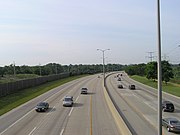
[edit] Mix Design
Modern concrete mix designs can be complex. The design of a concrete, or the way the weights of the components of a concrete is determined, is specified by the American Concrete Institute, the specifications of the project, and the building code where the project is located.
The design begins by determining the "durability" requirements of the concrete. These requirements take into consideration the weather conditions (freeze-thaw) that the concrete will be exposed to in service, and the required design strength, or f'c, at twenty eight (28) days after placement. The compressive strength of a concrete, fc, is determined by taking standard molded, standard-cured, 4"x8" or 6"x12", cylinder samples.
Many factors need to be taken into account, from the cost of the various additives and aggregates, to the trade offs between, the "slump" for easy mixing and placement and ultimate performance. These factors are also specified by the American Concrete Institute, project specifications, and the local building code where the project is located.
A mix is then designed using cement (Portland or other cementitious material), coarse and fine aggregates, water and chemical admixtures. The method of mixing will also be specified, as well as conditions that it may be used in.
This allows a user of the concrete to be confident that the structure will perform properly.
Various types of concrete have been developed for specialist application and have become known by these names.
[edit] Regular concrete
Regular concrete is the lay term describing concrete that is produced by following the mixing instructions that are commonly published on packets of cement, typically using sand or other common material as the aggregate, and often mixed in improvised containers. This concrete can be produced to yield a varying strength from about 10 MPa (1450 psi) to about 40 MPa (5800 psi), depending on the purpose, ranging from blinding to structural concrete respectively. Many types of pre-mixed concrete are available which include powdered cement mixed with an aggregate, needing only water.
Typically, a batch of concrete can be made by using 1 part Portland cement, 2 parts dry sand, 3 parts dry stone, 1/2 part water. The parts are in terms of weight – not volume. For example, 1-cubic-foot (0.028 m3) of concrete would be made using 22 lb (10.0 kg) cement, 10 lb (4.5 kg) water, 41 lb (19 kg) dry sand, 70 lb (32 kg) dry stone (1/2" to 3/4" stone). This would make 1-cubic-foot (0.028 m3) of concrete and would weigh about 143 lb (65 kg). The sand should be mortar or brick sand (washed and filtered if possible) and the stone should be washed if possible. Organic materials (leaves, twigs, etc) should be removed from the sand and stone to ensure the highest strength.
[edit] High-strength concrete
High-strength concrete has a compressive strength generally greater than 6,000 pounds per square inch (40 MPa = 5800 psi). High-strength concrete is made by lowering the water-cement (W/C) ratio to 0.35 or lower. Often silica fume is added to prevent the formation of free calcium hydroxide crystals in the cement matrix, which might reduce the strength at the cement-aggregate bond.
Low W/C ratios and the use of silica fume make concrete mixes significantly less workable, which is particularly likely to be a problem in high-strength concrete applications where dense rebar cages are likely to be used. To compensate for the reduced workability, superplasticizers are commonly added to high-strength mixtures. Aggregate must be selected carefully for high-strength mixes, as weaker aggregates may not be strong enough to resist the loads imposed on the concrete and cause failure to start in the aggregate rather than in the matrix or at a void, as normally occurs in regular concrete.
In some applications of high-strength concrete the design criterion is the elastic modulus rather than the ultimate compressive strength.
[edit] High-performance concrete
High-performance concrete (HPC) and Ultra-high-performance concrete are relatively new terms used to describe concrete that conforms to a set of standards above those of the most common applications, but not limited to strength. While all high-strength concrete is also high-performance, not all high-performance concrete is high-strength. Notable concrete-mixtures are: Ductal, concrete mixed with titanium oxide, ... Some examples of such standards currently used in relation to HPC are:
- Ease of placement
- Compaction without segregation
- Early age strength
- Long-term mechanical properties
- Permeability
- Density
- Heat of hydration
- Toughness
- Volume stability
- Long life in severe environments
- Depending on its implementation, environmental [25]
[edit] Self-consolidating concretes
During the 1980s a number of countries including Japan, Sweden and France developed concretes that are self-compacting, known as self-consolidating concrete in the United States. This self-consolidating concrete (SCCs) is characterized by:
- extreme fluidity as measured by flow, typically between 650-750 mm on a flow table, rather than slump(height)
- no need for vibrators to compact the concrete
- placement being easier.
- no bleed water, or aggregate segregation
- Increased Liquid Head Pressure, Can be detrimental to Safety and workmanship
SCC can save up to 50% in labor costs due to 80% faster pouring and reduced wear and tear on formwork.
As of 2005, self-consolidating concretes account for 10-15% of concrete sales in some European countries. In the US precast concrete industry, SCC represents over 75% of concrete production. 38 departments of transportation in the US accept the use of SCC for road and bridge projects.
This emerging technology is made possible by the use of polycarboxylates plasticizer instead of older naphthalene based polymers, and viscosity modifiers to address aggregate segregation.
[edit] Shotcrete
Shotcrete (also known by the trade name Gunite) uses compressed air to shoot concrete onto (or into) a frame or structure. Shotcrete is frequently used against vertical soil or rock surfaces, as it eliminates the need for formwork. It is sometimes used for rock support, especially in tunneling. Shotcrete is also used for applications where seepage is an issue to limit the amount of water entering a construction site due to a high water table or other subterranean sources. This type of concrete is often used as a quick fix for weathering for loose soil types in construction zones.
There are two application methods for shotcrete.
- dry-mix – the dry mixture of cement and aggregates is filled into the machine and conveyed with compressed air through the hoses. The water needed for the hydration is added at the nozzle.
- wet-mix – the mixes are prepared with all necessary water for hydration. The mixes are pumped through the hoses. At the nozzle compressed air is added for spraying.
For both methods additives such as accelerators and fiber reinforcement may be used.[26]
[edit] Pervious concrete
Pervious concrete contains a network of holes or voids, to allow air or water to move through the concrete.
This allows water to drain naturally through it, and can both remove the normal surface-water drainage infrastructure, and allow replenishment of groundwater when conventional concrete does not.
It is formed by leaving out some or all of the fine aggregate (fines), the remaining large aggregate then is bound by a relatively small amount of Portland Cement. When set, typically between 15% and 25% of the concrete volume are voids, allowing water to drain at around 5 gal/ft²/ min or 200 L/m²/min) through the concrete.
[edit] Installation
Pervious is installed by being poured into forms, then screeded off, to level (not smooth) the surface, then packed or tamped into place. Due to the low water content and air permeability, within 5-15 minutes of tamping, the concrete must be covered with a 6-mil poly plastic, or it will dry out prematurely and not properly hydrate and cure.
[edit] Characteristics
Pervious can significantly reduce noise, by allowing air to be squeezed between vehicle tires and the roadway to escape. This product cannot be used on major U.S. state highways currently due to the high psi ratings required by most states. Pervious has been tested up to 4500psi so far.
[edit] Cellular concrete
Aerated concrete produced by the addition of an air entraining agent to the concrete (or a lightweight aggregate like expanded clay pellets or cork granules and vermiculite) is sometimes called Cellular concrete.
[edit] Cork-cement composites
Waste Cork granules are obtained during production of bottle stoppers from the treated bark of Cork oak.[27] These granules have a density of about 300 kg/m³, lower than most lightweight aggregates used for making lightweight concrete. Cork granules do not significantly influence cement hydration, but cork dust may.[28] Cork cement composites have several advantages over standard concrete, such as lower thermal conductivities, lower densities and good energy absorption characteristics. These composites can be made of density from 400 to 1500 kg/m³, compressive strength from 1 to 26 MPa, and flexural strength from 0.5 to 4.0 MPa.
[edit] Roller-compacted concrete
Roller-compacted concrete, sometimes called rollcrete, is a low-cement-content stiff concrete placed using techniques borrowed from earthmoving and paving work. The concrete is placed on the surface to be covered, and is compacted in place using large heavy rollers typically used in earthwork. The concrete mix achieves a high density and cures over time into a strong monolithic block.[29] Roller-compacted concrete is typically used for concrete pavement, but has also been used to build concrete dams, as the low cement content causes less heat to be generated while curing than typical for conventionally placed massive concrete pours
[edit] Glass concrete
The use of recycled glass as aggregate in concrete has become popular in modern times, with large scale research being carried out at Columbia University in New York. This greatly enhances the aesthetic appeal of the concrete. Recent research findings have shown that concrete made with recycled glass aggregates have shown better long term strength and better thermal insulation due to its better thermal properties of the glass aggregates. [30]
[edit] Asphalt concrete
Strictly speaking, asphalt is a form of concrete as well, with bituminous materials replacing cement as the binder.
[edit] Rapid strength concrete
This type of concrete is able to develop high resistance within few hours after being manufactured. This feature has advantages such as removing the formwork early and to move forward in the building process at record time, repair road surfaces that become fully operational in just a few hours.
[edit] Rubberized concrete
While "rubberized asphalt concrete" is common, rubberized Portland cement concrete ("rubberized PCC") is still undergoing experimental tests, as of 2007[31] [32] [33] [34].
[edit] Polymer concrete
Polymer concrete is concrete which uses polymers to bind the aggregate. Polymer concrete can gain a lot of strength in a short amount of time. For example, a polymer mix may reach 5000 psi in only four hours. Polymer concrete is generally more expensive than conventional concretes.
[edit] Geopolymer or green concrete
Geopolymer concrete is a greener alternative to ordinary Portland cement made from inorganic aluminosilicate (Al-Si) polymer compounds that can utilise 100% recycled industrial waste (e.g. fly ash and slag) as the manufacturing inputs resulting in up to 80% lower carbon dioxide emissions. Greater chemical and thermal resistance, and better mechanical properties, are said to be achieved by the manufacturer at both atmospheric and extreme conditions.[35]
Similar concretes have not only been used in Ancient Rome (see Roman concrete) as mentioned but also in the former Soviet Union in the 1950s and 1960s. Buildings in the Ukraine are still standing after 45 years so that this kind of formulation has a sound track record.[36]
[edit] Limecrete
Limecrete or lime concrete is concrete where cement is replaced by lime.[37]
[edit] Refractory Cement
High-temperature applications, such as masonry ovens and the like, generally require the use of a refractory cement; concretes based on Portland cement can be damaged or destroyed by elevated temperatures, but refractory concretes are better able to withstand such conditions.
[edit] Concrete handling / Safety precautions
Handling of wet concrete must always be done with proper protective equipment. Contact with wet concrete can cause severe skin burns due to causticity of the mix with cement and water.
[edit] Concrete testing
Engineers usually specify the required compressive strength of concrete, which is normally given as the 28 day compressive strength in megapascals (MPa) or pounds per square inch (psi). Twenty eight days is a long wait to determine if desired strengths are going to be obtained, so three-day and seven-day strengths can be useful to predict the ultimate 28-day compressive strength of the concrete. A 25% strength gain between 7 and 28 days is often observed with 100% OPC (ordinary Portland cement) mixtures, and up to 40% strength gain can be realized with the inclusion of pozzolans and supplementary cementitious materials (SCMs) such as fly ash and/or slag cement. Strength gain depends on the type of mixture, its constituents, the use of standard curing, proper testing and care of cylinders in transport, etc. It is imperative to accurately test the fundamental properties of concrete in its fresh, plastic state.
Concrete is typically sampled while being placed, with testing protocols requiring that test samples be cured under laboratory conditions (standard cured). Additional samples may be field cured (non-standard) for the purpose of early 'stripping' strengths, that is, form removal, evaluation of curing, etc. but the standard cured cylinders comprise acceptance criteria. Concrete tests can measure the "plastic" (unhydrated) properties of concrete prior to, and during placement. As these properties affect the hardened compressive strength and durability of concrete (resistance to freeze-thaw), the properties of workability (slump/flow), temperature, density and age are monitored to ensure the production and placement of 'quality' concrete. Tests are performed per ASTM International, European Committee for Standardization or Canadian Standards Association. As measurement of quality must represent the potential of concrete material delivered, placed and properly cured, it is imperative that concrete technicians performing concrete tests are certified to do so according to these standards. Structural design, material design and properties are often specified in accordance with national/regional design codes such as American Concrete Institute.
Compressive-strength tests are conducted using an instrumented hydraulic ram to compress a cylindrical or cubic sample to failure. Tensile strength tests are conducted either by three-point bending of a prismatic beam specimen or by compression along the sides of a cylindrical specimen.
[edit] Concrete recycling
Concrete recycling is an increasingly common method of disposing of concrete structures. Concrete debris was once routinely shipped to landfills for disposal, but recycling is increasing due to improved environmental awareness, governmental laws, and economic benefits.
Concrete, which must be free of trash, wood, paper and other such materials, is collected from demolition sites and put through a crushing machine, often along with asphalt, bricks, and rocks.
Reinforced concrete contains rebar and other metallic reinforcements, which are removed with magnets and recycled elsewhere. The remaining aggregate chunks are sorted by size. Larger chunks may go through the crusher again. Smaller pieces of concrete are used as gravel for new construction projects. Aggregate base gravel is laid down as the lowest layer in a road, with fresh concrete or asphalt placed over it. Crushed recycled concrete can sometimes be used as the dry aggregate for brand new concrete if it is free of contaminants, though the use of recycled concrete limits strength and is not allowed in many jurisdictions. On March 3, 1983, a government funded research team (the VIRL research.codep) approximated that almost 17% of worldwide landfill was by-products of concrete based waste.
Recycling concrete provides environmental benefits, conserving landfill space and use as aggregate reduces the need for gravel mining.
[edit] Use of concrete in infrastructure

[edit] Mass concrete structures
These include gravity dams such as the Itaipu, Hoover Dam and the Three Gorges Dam and large breakwaters. Concrete that is poured all at once in one block (so that there are no weak points where the concrete is "welded" together) is used for tornado shelters.
[edit] Concrete Textures
When one thinks of concrete, oftentimes the image of a dull, gray concrete wall comes to mind. Nevertheless, with the use of formliner, concrete can be cast and molded into different textures. Sound/retaining walls, bridges, office buildings and more serve as the optimal canvases for concrete art.
For example, the Pima Freeway/Loop 101 retaining and sound walls in Scottsdale, Arizona, feature desert flora and fauna, a 67-foot lizard and 40-foot cacti along the 8-mile stretch. The project, titled "The Path Most Traveled," is one example of how concrete can be shaped using elastomeric formliner.
[edit] Reinforced concrete structures
Reinforced concrete contains steel reinforcing that is designed and placed in structural members at specific positions to cater for all the stress conditions that the member is required to accommodate.
[edit] Prestressed concrete structures
Prestressed concrete is a form of reinforced concrete which builds in compressive stresses during construction to oppose those found when in use. This can greatly reduce the weight of beams or slabs, by better distributing the stresses in the structure to make optimal use of the reinforcement.
For example a horizontal beam will tend to sag down. If the reinforcement along the bottom of the beam is prestressed, it can counteract this.
In pre-tensioned concrete, the prestressing is achieved by using steel or polymer tendons or bars that are subjected to a tensile force prior to casting, or for post-tensioned concrete, after casting.
[edit] Concrete Paving to Lower City Temperatures
Using light-colored concrete has proven effective in reflecting up to 50% more light than asphalt and reducing ambient temperature.[38] A low albedo value, characteristic of black asphalt, absorbs a large percentage of solar heat and contributes to the warming of cities. By paving with light colored concrete, in addition to replacing asphalt with light-colored concrete, communities can lower their average temperature.[39]
Many U.S. cities show that pavement comprise approximately 30-40% of their surface area.[38] This directly impacts the temperature of the city, as demonstrated by the urban-heat-island effect. In addition to decreasing the overall temperature of parking lots and large paved areas by paving with light-colored concrete, there are supplemental benefits. One example is 10-30% improved nighttime visibility.[38] The potential of energy saving within an area is also high. With lower temperatures, the demand for air conditioning decreases, saving vast amounts of energy.
Atlanta has tried to mitigate the heat-island effect. City officials noted that when using heat-reflecting concrete, their average city temperature decreased by 6 °F.[40] New York City offers another example. The Design Trust for Public Space in New York City found that by slightly raising the albedo value in their city, beneficial effects such as energy savings could be achieved. It was concluded that this could be accomplished by the replacement of black asphalt with light-colored concrete.[39]
[edit] See also
|
|
[edit] References
- ^ The Skeptical Environmentalist: Measuring the Real State of the World, by Bjorn Lomborg, p 138.
- ^ "Minerals commodity summary - cement - 2007". 2007-06-01. http://minerals.usgs.gov/minerals/pubs/commodity/cement/index.html. Retrieved on 2008-01-16.
- ^ http://www.allacademic.com/meta/p_mla_apa_research_citation/0/2/0/1/2/p20122_index.html
- ^ http://www.djc.com/special/concrete/10003364.htm
- ^ Fountain, Henry (March 30, 2009). "Concrete Is Remixed With Environment in Mind". The New York Times. http://www.nytimes.com/2009/03/31/science/earth/31conc.html. Retrieved on 2009-03-30.
- ^ Missing File
- ^ a b U.S. Federal Highway Administration. "Admixtures". http://www.fhwa.dot.gov/infrastructure/materialsgrp/admixture.html. Retrieved on 2007-01-25.
- ^ Cement Admixture Association. "CAA". www.admixtures.org.uk. http://www.admixtures.org.uk/publications.asp. Retrieved on 2008-04-02.
- ^ Kosmatka, S.H.; Panarese, W.C. (1988). Design and Control of Concrete Mixtures. Skokie, IL, USA: Portland Cement Association. pp. 17, 42, 70, 184. ISBN 0-89312-087-1.
- ^ U.S. Federal Highway Administration. "Fly Ash". http://www.fhwa.dot.gov/infrastructure/materialsgrp/flyash.htm. Retrieved on 2007-01-24.
- ^ U.S. Federal Highway Administration. "Ground Granulated Blast-Furnace Slag". http://www.fhwa.dot.gov/infrastructure/materialsgrp/ggbfs.htm. Retrieved on 2007-01-24.
- ^ U.S. Federal Highway Administration. "Silica Fume". http://www.fhwa.dot.gov/infrastructure/materialsgrp/silica.htm. Retrieved on 2007-01-24.
- ^ Premixed Cement Paste
- ^ The use of micro- and nanosilica in concrete
- ^ Measuring, Mixing, Transporting, and Placing Concrete
- ^ U.S. Patent 5,443,313 - Method for producing construction mixture for concrete
- ^ "Concrete Testing". http://technology.calumet.purdue.edu/cnt/rbennet/concrete%20lab.htm. Retrieved on 2008-11-10.
- ^ a b ACI Committee 318 (2008). ACI 318-08: Building Code Requirements for Structural Concrete and Commentary. American Concrete Institute. ISBN 0870312642.
- ^ David Hambling (April 13, 2007). "Iran's Invulnerable Bunkers?". Wired. http://blog.wired.com/defense/2007/04/irans_superconc.html. Retrieved on 2008-01-29.
- ^ "Thermal Coefficient of Portland Cement Concrete". Portland Cement Concrete Pavements Research. Federal Highway Administration. http://www.fhwa.dot.gov/pavement/pccp/thermal.cfm. Retrieved on 2008-01-29.
- ^ Jones, Katrina (1999). "Density of Concrete". The Physics Factbook. http://hypertextbook.com/facts/1999/KatrinaJones.shtml.
- ^ Norwegian Building Research Institute, publication 24. Fire-damage to buildings.
- ^ "Accelerating Concrete Set Time". 1999-06-01. http://www.fhwa.dot.gov/infrastructure/materialsgrp/acclerat.htm. Retrieved on 2007-01-16.
- ^ ;Kejin Wanga, Daniel E. Nelsena and Wilfrid A. Nixon, "Damaging effects of deicing chemicals on concrete materials", Cement and Concrete Composites Vol. 28(2), pp 173-188. doi:10.1016/j.cemconcomp.2005.07.006
- ^ Time:Cementing the future
- ^ American Shotcrete Association Homepage
- ^ Gibson, L.J. & Ashby, M.F. 1999. Cellular Solids: Structure and Properties; 2nd Edition (Paperback), Cambridge Uni. Press. pp.453-467.
- ^ Karade S.R., Irle M.A., Maher K. 2006. Influence of granule properties and concentration on cork-cement compatibility. Holz als Roh- und Werkstoff. 64: 281–286 (DOI 10.1007/s00107-006-0103-2).
- ^ Roller-Compacted Concrete (RCC) Pavements | Portland Cement Association (PCA)
- ^ http://www.sciencedirect.com/science?_ob=ArticleListURL&_method=list&_ArticleListID=687884626&_sort=d&view=c&_acct=C000014338&_version=1&_urlVersion=0&_userid=208107&md5=63a74de0d7e38203d0fc8dbb3107393c
- ^ Crumb Rubber Concrete - Precast Solutions Magazine Fall 2004
- ^ Emerging Construction Technologies
- ^ ASU researcher puts recalled Firestone tires to good use
- ^ Experimental Study on Strength, Modulus of Elasticity, and Damping Ratio of Rubberized Concrete
- ^ Zeobond is one such manufacturer that has built and operates the world’s first geopolymer concrete plant for the local Australian market with several additional plants coming online in Asia and North America in 2008. According to this manufacturer its E-Crete branded concrete can be used in all applications where concrete is used today.
- ^ Green Cement ABC Catalyst program first broadcast 22 May 2008.
- ^ An Investigation Into The Feasibility Of Timber And Limecrete Composite Flooring
- ^ a b c "Cool Pavement Report" (PDF). Environmental Protection Agency. June 2005. http://www.epa.gov/heatisland/resources/pdf/CoolPavementReport_Former%20Guide_complete.pdf. Retrieved on 2009-02-06.
- ^ a b Gore, A; Steffen, A (2008). World Changing: A User's Giode for the 21st Century. New York: Abrams. pp. 258.
- ^ "Concrete facts". Pacific Southwest Concrete Alliance. http://www.concreteresources.net/categories/4F26A962-D021-233F-FCC5EF707CBD860A/fun_facts.html. Retrieved on 2009-02-06.
[edit] External links
| Wikimedia Commons has media related to: Concrete |
[edit] Related article and publications
- Refractory Concrete Information related to heat resistant concrete; recipes, ingredients mixing ratio, work with and applications.
- The effect of curing on the tensile strength of medium to high strength concrete
- The History of Concrete
- Concrete carbonation chemistry at the TU Dresden
- Howard Kanare - Problems With Moisture in Concrete
- Concrete Moisture Testing - Relative Humidity vs. Calcium Chloride
- Free Concrete Books :
|
|||||||||||||||||||||||||||||||||||||||


